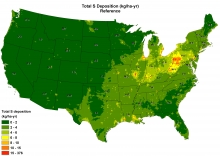You are here
New SPE Study: Rules on Carbon Emissions Benefit People & the Environment

On June 2, the EPA released the nation’s first-ever carbon pollution standards for existing power plants. In a new report by the Science Policy Exchange, scientists from Syracuse and Harvard analyze how and where that rule will improve local air quality, decrease atmospheric deposition, and benefit people and ecosystems across the U.S.
The authors of the study, including Kathy Fallon Lambert of the Harvard Forest, used three policy options for the EPA rule as a guide to model changes in power plant emissions over the next 6 years.
In addition to summarizing changes in emissions, the study quantifies the resulting improvements in air quality. Detailed maps illustrate the benefits of decreased emissions from roughly 2,400 power plants in the continental U.S., analyzing the country 12x12km at a time. The maps show that the greatest air quality benefits will occur in the eastern U.S., particularly in states in and around the Ohio River Valley, as well as the Rocky Mountain region.
- Download the report: Co-benefits of Carbon Standards: Air Pollution Changes under Different 111d Options for Existing Power Plants.
- Browse stories in the Harvard Gazette, USA Today, and The Washington Post.
- Explore key maps and graphs from the study.
- Read the press release: Rules to cut carbon emissions also reduce air pollution harmful to people and the environment.
- Learn more about the Science Policy Exchange.

